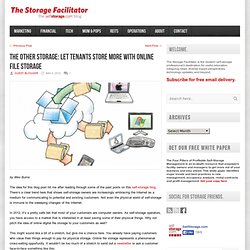

The Other Storage: Let Tenants Store More With Online File Storage. By Wes Burns The idea for this blog post hit me after reading through some of the past posts on this self-storage blog.

There’s a clear trend here that shows self-storage owners are increasingly embracing the Internet as a medium for communicating to potential and existing customers. Not even the physical world of self-storage is immune to the sweeping changes of the Internet. In 2012, it’s a pretty safe bet that most of your customers are computer owners. As self-storage operators, you have access to a market that is interested in at least saving some of their physical things. This might sound like a bit of a stretch, but give me a chance here. “Do you also have important things on your computer that you would like to keep safe?” Admittedly, online storage and physical storage are two completely different industries, despite sharing a name. If you’re interested in adding a new revenue stream to your business, online storage is worth considering.
Let’s use ZipCloud.com as an example. The economics of self-storage: The golden hoard. THE best businesses take unpromising inputs and conjure from them a stable stream of profits.

Self-storage firms fall into this category. They offer space-strapped customers a secure nest in which to store things they don’t need right now but can’t bring themselves to throw away. They invest in land most developers would shun and use tenancy contracts that would make other landlords shudder. Yet they are big business in America, where one family in ten uses one of the countries’ 50,000 facilities. It’s a sector that has seen robust performance and rapid growth, according to the Self Storage Association, an industry body. To appreciate the magic of the business model, start with the ropy ingredients.
Structured as Real Estate Investment Trusts (REITS), which pool cash to invest in property, they have avoided the sinking feeling that has dominated the REIT sector for the past five years. There are two reasons for the storage firms’ success. Photos: New York's Classic Car Club. Alex Davies The 1966 Mustang Fastback is one of many classic cars members get to drive.

There are few pleasures in life equal to driving a really great car, especially if it was built in the 1960s and can still turn heads on the street. That is why more than 300 drivers have joined the Classic Car Club, the private, luxury club that offers the chance to drive an amazing stable of more than 40 classic cruisers and modern supercars. Its motto: "Join the Club. Drive the Cars. " At the invitation of Director Michael Prichinello, I spent a few days as a member, joining the ranks of Robert Downey, Jr., Jay-Z (who apparently never used his membership), Tumblr CEO David Karp, and more, with full access to an amazing fleet of classic and current Lamborghinis, Porsches, Ferraris, and more. Deciding what to drive was not an easy task, but it was certainly a fun one.
Finance. Green Building Improvements For Self-Storage Facilities. As a relatively energy-efficient industry, self-storage is uniquely poised to show its mettle as a leading force for sustainability this Earth Day season. Whether you’re developing a new facility or revamping an old one, there are many steps, large and small, that owners and operators can take to make their facility a beacon of eco-friendly construction. Building a more efficient facility In a recent report by Bryan Hurlburt of Green Garage Lighting, a facility in Stafford, CT found that their fluorescent lighting system could be revamped with LEDs to cut energy consumption and cost almost in half. With the new LED system, high installation and maintenance costs associated with fluorescent tubes were eliminated, and Stafford enjoyed a 35% decrease on their energy use compared to the previous year. But the changeover has larger implications than a smaller electric bill. According to the article, their saved energy prevented 21,738 pounds of carbon emissions.